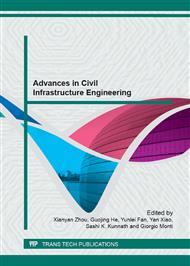[1]
A. K. Chopra. Dynamics of Structures: Theory and Applications to Earthquake Engineering (Third Edition, Reprint edition). Tsinghua University press, (2009)
Google Scholar
[2]
IBRAHIMBEGOVIC A, CHEN H C,WILSON E L. Ritz Method for Dynamic Analysis of large Discrete Linear Systems with Non-Proportional Damping. Earthquake Engineering and Structural Dynamics, 19: 877- 889, (1990)
DOI: 10.1002/eqe.4290190608
Google Scholar
[3]
M. Tong, Z. Liang and G. C. Lee. An Index of Damping Non-proportionality for Discrete Vibrating Systems. Journal of Sound and Vibration, 174(1): 37-55, (1994)
DOI: 10.1006/jsvi.1994.1554
Google Scholar
[4]
C. T. SUN, J. M. BAI. Vibration of Multi-Degree-of-Freedom Systems with Non-Proportional Viscous Damping. Int. J. Mech. Sci. , 37(4): 441-455, (1995)
DOI: 10.1016/0020-7403(95)00067-8
Google Scholar
[5]
S. Adhikari. Calculation of Derivative of Complex Modes Using Classical Normal Modes. Computers & Structures, 77: 625-633, (2000)
DOI: 10.1016/s0045-7949(00)00016-x
Google Scholar
[6]
S. Adhikari and J. Woodhouse. Identification of Damping: Part 1, Viscous Damping. Journal of Sound and Vibration, 243(1): 43-61, (2001)
DOI: 10.1006/jsvi.2000.3391
Google Scholar
[7]
Lin FB, Wang YK, Chao YS. A Pseudo-Force Iterative Method with Separate Scale Factors for Dynamic Analysis of Structures with Non-Proportional Damping. Earthquake Engineering and Structural Dynamics, 32(2): 329-337, (2003)
DOI: 10.1002/eqe.234
Google Scholar
[8]
Zhou X Y, Yu R F, Dong D. Complex Mode Superposition Algorithm for Seismic Responses of Non-classically Damped Linear System. Journal of Earthquake Engineering, 8(4): 597- 641, (2004)
DOI: 10.1080/13632460409350503
Google Scholar
[9]
Karen K, Mohsen G. A. New approaches for Non-Classically Damped System Eigenanalysis. Earthquake Engineering and Structural Dynamics, 34(9): 1073-1087 ,(2005)
DOI: 10.1002/eqe.467
Google Scholar
[10]
A. H. Nayfeh, D. T. Mook. Nonlinear Oscillations. New York: Wiley, (1979)
Google Scholar


